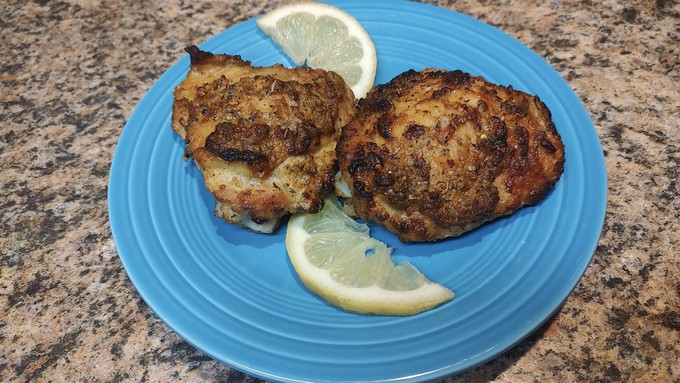
Recipe: Baked lemon-Dijon chicken thighs with herbs

Chicken thighs achieve crispy deliciousness when marinated and baked at high heat. Debbie Arrington
Lemon, Dijon mustard and spring herbs create a flavorful marinade for this easy baked chicken dish. Lemons are still plentiful in March, when mustard is in full bloom. Lemons also are a nice complement to Dijon mustard, parsley and early-season perennial herbs such as oregano and thyme. That’s why this combination is perfect for the new season (or any time).
Chicken thighs are moist, economical and cook fast, which makes this main course ideal for weeknights, too. The chicken can marinate in the refrigerator during the day. Then pop it in the oven for dinner. The high baking temperature (425 degrees F.) crisps the chicken skin. The finishing salt gives it a little extra crunch.
Baked lemon-Dijon chicken thighs with spring herbs
Makes 3 to 4 servings
Ingredients:
6 chicken thighs (about 2 pounds)
2 lemons
½ cup olive oil
2 tablespoons Dijon mustard
1 tablespoon fresh parsley, finely chopped, or 1 teaspoon dried parsley
1 tablespoon fresh oregano, finely chopped, or 1 teaspoon dried oregano
1 teaspoon fresh thyme or ½ teaspoon dried thyme
1 teaspoon garlic salt
1 teaspoon freshly ground black pepper
½ teaspoon red pepper flakes
Kosher or other coarse-grain salt, if desired
Instructions:
Trim any excess fat off of thighs. Pat dry.
Zest both lemons. Juice one lemon and reserve the other for later.
In a large bowl, whisk together lemon zest and juice, olive oil, Dijon mustard, parsley, oregano, thyme, garlic salt, black pepper and red pepper flakes. Add chicken thighs to the marinade and turn to coat well. Let thighs marinate for at least 30 minutes. (If longer, cover and refrigerate while marinating, then bring to room temperature before baking.)
Preheat the oven to 425 degrees F. Line a rimmed sheet pan or shallow baking dish with foil or parchment paper. Make sure the dish is big enough that there’s room between each thigh.
Remove thighs from marinade and place, skin side up, on the covered pan or baking dish. Brush marinade over the top of thighs so each is well covered. Sprinkle a little kosher salt or other coarse salt over the top, if desired.
Bake at 425 degrees for 30 to 35 minutes or until thighs are golden brown and meat juices are clear when thighs are pierced with a thin-bladed knife.
Cut remaining lemon and squeeze over the top of thighs just before serving.
Comments
0 comments have been posted.Sacramento Digs Gardening to your inbox.
Sites We Like
Garden Checklist for week of July 21
Your garden needs you!
* Keep your vegetable garden watered, mulched and weeded. Water before 8 a.m. to reduce the chance of fungal infection and to conserve moisture.
* Feed vegetable plants bone meal, rock phosphate or other fertilizers high in phosphate to stimulate more blooms and fruiting. (But wait until daily high temperatures drop out of the 100s.)
* Don’t let tomatoes wilt or dry out completely. Give tomatoes a deep watering two to three times a week.
* Harvest vegetables promptly to encourage plants to produce more. Squash especially tends to grow rapidly in hot weather. Keep an eye on zucchini.
* Pinch back chrysanthemums for bushy plants and more flowers in September.
* Remove spent flowers from roses, daylilies and other bloomers as they finish flowering.
* Pinch off blooms from basil so the plant will grow more leaves.
* Cut back lavender after flowering to promote a second bloom.
* It's not too late to add a splash of color. Plant petunias, snapdragons, zinnias and marigolds.
* From seed, plant corn, pumpkins, radishes, winter squash and sunflowers.